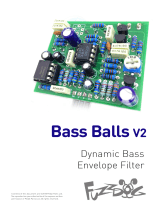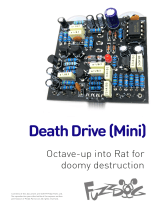Page is loading ...

Tigger Buffer
Invigorate your signal chain
Contents of this document are ©2022 Pedal Parts Ltd.
No reproduction permitted without the express written
permission of Pedal Parts Ltd. All rights reserved.

Important notes
If you’re using any of our footswitch daughterboards,
DOWNLOAD THE DAUGHTERBOARD DOCUMENT
•Download and read the appropriate build document for the daughterboard
as well as this one BEFORE you start.
•DO NOT solder the supplied Current Limiting Resistor (CLR) to the main
circuit board even if there is a place for it. This should be soldered to the
footswitch daughterboard.
POWER SUPPLY
Unless otherwise stated in this document this circuit is designed to be
powered with 9V DC.
COMPONENT SPECS
Unless otherwise stated in this document:
•Resistors should be 0.25W. You can use those with higher ratings but
check the physical size of them.
•Electrolytics caps should be at least 25V for 9V circuits, 35V for 18V
circuits. Again, check physical size if using higher ratings.
LAYOUT CONVENTIONS
Unless otherwise stated in this document, the following are used:
•Electrolytic capacitors:
Long leg (anode) to square pad.
•Diodes/LEDs:
Striped leg (cathode) to square pad. Short leg to square pad for LEDs.
•ICs:
Square pad indicates pin 1.

Schematic + BOM
R1 1M
R2 1M
R3 100K
R4 10K
R5 100R
CLR 2K2*
C1 22n
C2 22n
C3 2u2 elec
C4 47u elec
D1 1N4001
D2 LED
IC LF356N
‘Spring Thing’ is a battery contact, part no. Keystone 629
*Or whatever value you prefer. Lower value = brighter LED.

Be very careful when soldering the diode and
LED. They’re very sensitive to heat. You should
use some kind of heat sink (crocodile clip or
reverse action tweezers) on each leg as you
solder them. Keep exposure to heat to a
minimum (under 2 seconds).
Use a socket for the IC or be extra careful when
soldering.
Positive (anode) legs of the electrolytic caps go
to the square pads.
Negative (cathode) legs of the diode goes to the
square pad.
J1 is input, J2 is output.
Don’t sweat grounding the circuit to the
enclosure - the ‘spring thing’ will do that.
The long leg of the LED goes into the round pad.
Leave the LED until last. Solder in everything
else - components first, then DC and jack
sockets. Check it all fits the enclosure OK.
Now push your LED legs into their pads and
leave it loose. Get your circuit into the enclosure
and fasten up the jack sockets. Once in place,
position your LED through the hole in the
enclosure and solder it in.
For the jack sockets, one plastic washer goes on
the inside of the enclosure.
If you’ve opted for a wired DC socket take wires
from the V and G pads at the front of the PCB
near the DC space (shown above). The long pin
of the mini DC socket is the +V.
The kit is designed to go sockets-down in the
enclosure, with the bottom of thePCB facing the
open side.
PCB layout ©2018 Pedal Parts Ltd.

This template is a rough guide only. You should ensure correct marking of your
enclosure before drilling. You use this template at your own risk.
Pedal Parts Ltd can accept no responsibility for incorrect drilling of enclosures.
FuzzDog.co.uk
Drilling template
Hammond 1590A
31 x 90 x 27 mm
Recommended drill sizes:
Jacks 12mm
DC Socket 8-10mm
48mm
2mm
48mm
2mm
23mm
The wired mini DC sockets require an 8mm hole.
If you’re using a board-mounted DC socket you need to have a hole big enough so
that the sleeve of the plug doesn’t touch the enclosure. 10mm should suffice.
Top
Side
Board-mounted DC
Side
Wired DC
/









